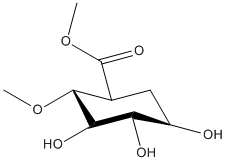MeGlcA2
General
Type : Natural || Glucuronoyl || Carbohydrate
Chemical_Nomenclature :
Canonical SMILES : C1(C(C(C(CC1C(=O)OC)O)O)O)OC
InChI : InChI=1S\/C9H16O6\/c1-14-8-4(9(13)15-2)3-5(10)6(11)7(8)12\/h4-8,10-12H,3H2,1-2H3
InChIKey : YLTRAXPJJUZDOP-UHFFFAOYSA-N
Other name(s) :
MW : 220.22
Formula : C9H16O6
CAS_number :
PubChem :
UniChem :
Iuphar :

Target
Families : Glucuronoyl_esterase
References (2)
| Title : The structural basis of fungal glucuronoyl esterase activity on natural substrates - Ernst_2020_Nat.Commun_11_1026 |
| Author(s) : Ernst HA , Mosbech C , Langkilde AE , Westh P , Meyer AS , Agger JW , Larsen S |
| Ref : Nat Commun , 11 :1026 , 2020 |
| Abstract : Ernst_2020_Nat.Commun_11_1026 |
| ESTHER : Ernst_2020_Nat.Commun_11_1026 |
| PubMedSearch : Ernst_2020_Nat.Commun_11_1026 |
| PubMedID: 32094331 |
| Gene_locus related to this paper: cerui-gce |
| Title : Expression and characterization of two glucuronoyl esterases from Thielavia terrestris and their application in enzymatic hydrolysis of corn bran - Tang_2019_Appl.Microbiol.Biotechnol_103_3037 |
| Author(s) : Tang J , Long L , Cao Y , Ding S |
| Ref : Applied Microbiology & Biotechnology , 103 :3037 , 2019 |
| Abstract : Tang_2019_Appl.Microbiol.Biotechnol_103_3037 |
| ESTHER : Tang_2019_Appl.Microbiol.Biotechnol_103_3037 |
| PubMedSearch : Tang_2019_Appl.Microbiol.Biotechnol_103_3037 |
| PubMedID: 30762074 |
| Gene_locus related to this paper: thite-g2r8b5 , thite-g2rcm8 |